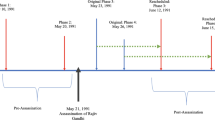Abstract
This research considers the effects of reapportionment on partisan competition. More precisely, this study develops a set of specifications under which we might expect varying effects of reapportionment on electoral patterns. By considering the history of political competition in the state, the geographic distribution of partisans, the history and methods of previous apportionments, and the political nature of the reapportionment, a set of specific hypotheses regarding the effects can be deduced. The theory is tested by application of it to the state of Oklahoma. Utilizing an interrupted time-series analysis of election results, we conclude that the 1964 reapportionment in Oklahoma had immediate electoral consequences. The 1971 reapportionment had virtually no effect. These findings are consistent with the expectations based on the theory developed in the paper.
Similar content being viewed by others
References
Baker, Gordon E. (1968). One person, one vote. In Robert A. Goldwin (ed.),Representation and Misrepresentation, pp. 71–90. New York: Rand McNally.
Bingham, Richard D. (1972).Reapportionment of the Oklahoma House of Representatives: Politics and Process. Norman, OK: Bureau of Government Research, University of Oklahoma.
David, Paul T., and Eisenberg, Ralph (1962).State Legislative Districting. Chicago: Public Administration Service.
Dixon, Robert G., Jr. (1968).Democratic Representation: Reapportionment in Law and Politics. New York: Oxford University Press.
Erickson, Robert S. (1971). The partisan impact of state legislative reapportionment.Midwest Journal of Political Science 15: 57–71.
Hamilton, Howard (1967). Legislative constituencies: single-member districts, multimember districts, and floterial districts.Western Political Quarterly 20: 321–340.
Jewell, Malcolm E. (1966). The political setting. In Alexander Heard (ed.),State Legislatures in American Politics. Englewood Cliffs, NJ: Prentice-Hall.
Jewell, Malcolm E. (1967).Legislative Representation in the Contemporary South. Durham, NC: Duke University Press.
Jewell, Malcolm E. (1969).Metropolitan Representation: State Legislative Districting in Urban Counties. National Municipal League.
Jewell, Malcolm E., and Patterson, Samuel C. (1977).The Legislative Process in the United States, third ed. New York: Random House.
Lewis-Beck, Michael S. (1986). Interrupted time series. In William D. Berry and Michael S. Lewis-Beck (eds.),New Tools for Social Scientists, pp. 209–240. Beverly Hills, CA: Sage.
Lewis-Beck, Michael S., and Alford, John R. (1980). Can government regulate safety? The coal mine example.American Political Science Review 74: 745–756.
Mauer, George J. (1964). Political equality and legislative apportionment in Oklahoma. Unpublished Ph.D. dissertation, University of Oklahoma.
McDonald, Jean G. (1982).State Legislative Competition in a Changing Party System: The Case of Oklahoma. Norman: Bureau of Government Research, University of Oklahoma.
McKay, Robert B. (1965).Reapportionment: The Law and Politics of Equal Representation. New York: Twentieth Century Fund.
Meier, Kenneth J. (1980). Executive reorganization of government: impact on employment and expenditures,American Journal of Political Science 24: 396–412.
O'Rourke, Timothy (1980).The Impact of Reapportionment. New Brunswick, NJ: Transaction Books.
Pulsipher, Allan G., and Weatherby, James L. (1968). Malapportionment, party competition, and the functional distribution of governmental expenditures,American Political Science Review 62: 1207–1219.
Schubert, Glendon, and Press, Charles (1964). Measuring malapportionment.American Political Science Review 58: 302–327.
Singleton, J. Allen (1981). Oklahoma. In Leroy C. Hardy, Alan Heslop, and Stuart Anderson (eds.),Reapportionment Politics: The History of Redistricting in 50 States, pp. 266–270. Beverly Hills, CA: Sage Publications.
Uslaner, Eric M., and Weber, Ronald E. (1977). Reapportionment, gerrymandering, and change in the partisan balance of power in the American states. Paper delivered at the annual meeting of the American Political Science Association.
Author information
Authors and Affiliations
Rights and permissions
About this article
Cite this article
Copeland, G.W., McDonald, J.G. Reapportionment and partisan competition: When does reapportionment matter?. Polit Behav 9, 160–173 (1987). https://doi.org/10.1007/BF00987304
Issue Date:
DOI: https://doi.org/10.1007/BF00987304




